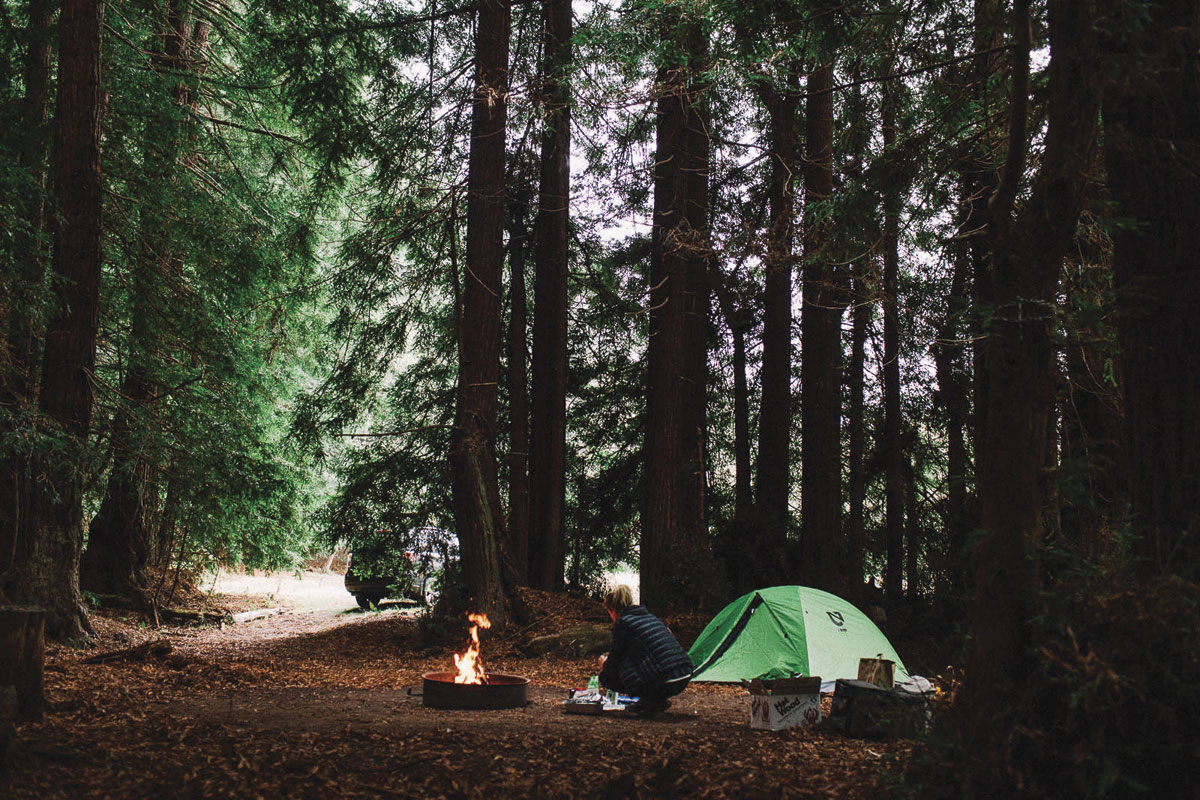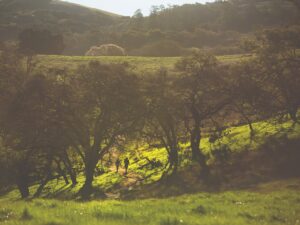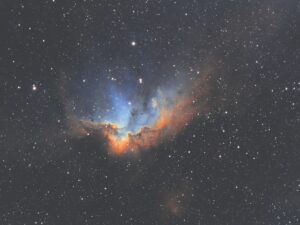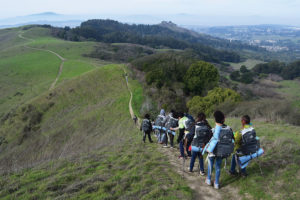AN HOUR BEFORE April’s first sunrise, I wriggle out of my sleeping bag and unzip my tent flap to the chatter of birdsong. I listen for a moment—between the phrases of a robin’s song, there’s an owl hoo-hooing—but I don’t pause long. Here in the grove of redwoods that marks Camp Site 1 at Salmon Creek Ranch in western Sonoma County, it’s cold enough to get me moving, shuffling through the leaf litter toward the meadow bordering my campsite. From there I’ll be able to pick a route up the hill to catch the sunrise.
Standing in the damp grass, I assess my options: A web of trails branches up into the forest to the right, but they look too dark. A wide, grassy route follows the creek behind me but won’t take me uphill. Before me, the rocky, fern-flanked road I drove in on the day before looks promising. That’s my choice—and as a bonus it means I’ll see the animals.
Two thirds of my way up the hill, as the first rays of sunlight pierce through the Douglas fir canopy, I get my wish. Here come two large beige dogs barking at me as they lope along the fence line. Behind them is a group of knobby-kneed goats silhouetted by the sun. Shaggy-haired cattle trot along the driveway, which stretches out for another mile or two.
Pausing at the fence at the top of the hill and looking east, I can see to the next tree-lined ridge of hills and the valley between us cradling the fog. Most of my view is of sloping pastures, pale green in the morning light. The hills and meadows along Salmon Creek are almost entirely ranchland and have been for generations. In their midst are tiny towns like nearby Bodega. The rocky ocean inlet of Bodega Bay is just four miles west of here. Standing at the high point of Salmon Creek Ranch, I realize that this is my favorite kind of backyard camping, where the backyard isn’t mine and it stretches for 400 acres.
I found my camping site at Salmon Creek Ranch through Hipcamp, a business that facilitates camping both on public and private land. Private landowners may list any site where campers can “connect with nature.” Some of the sites are so remote you can only access them by kayak; others offer tipis and yurts for shelter. At Salmon Creek, the two campsites are traditional: picnic tables, Porta-Potties, fire rings, and sheltered spaces for pitching tents.
Salmon Creek Ranch is a far cry from camping in wilderness, but I see plenty of wildlife: Hawks glide over the pastures; red-winged blackbirds flit by in flashes of color. While the dogs are on alert for bobcats and mountain lions and coyotes, I watch ravens perch along the duck pasture fences—they’ve been known to sneak in, steal eggs, and fly off with them wedged in their beaks. I walk over gopher holes that show signs great blue herons were hunting their denizens, and catch a glimpse of a garter snake slithering through the grass. Sure, there are cattle and domesticated ducks and dogs—the place is a ranch. But it’s more than that.
“It’s what we call the middle space,” Alyssa Ravasio says. Ravasio is the CEO and founder of Hipcamp, and she laughs in recognition when I tell her the ranch had the feel of wilderness, despite harboring people and livestock. “For too long we’ve looked at land use as binary,” she says, referring to protected and nonprotected areas. “We’re either going to not touch it, like there’s a glass pane between us and the land, or we completely exploit it. But we don’t have to destroy everything we touch. We’re an important part of the ecosystem.”
What she means is that we haven’t separated these lands for conservation, but there’s room to protect what’s wild within them nonetheless. Perhaps the middle space—private land with conservation potential—can remind us how to live better with the land. Perhaps it can teach us what it means to be an important part of an ecosystem.
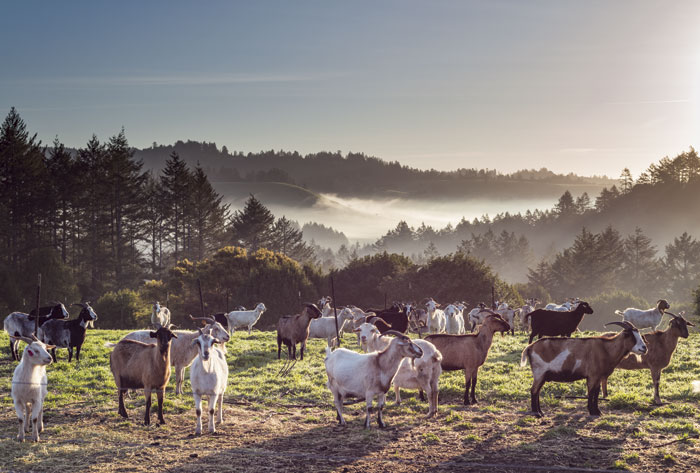
LESLEY BRABYN stands in the grove of redwoods with her hands on her hips. Afternoon sunlight is streaming in, highlighting wisps from the mop of brown hair she wears piled on her head. I ask her about the red-haired cattle I had encountered on my morning walk.
“Those are Scottish Highlanders,” Lesley confirms. “They’re curious little puppies. Sometimes they come down to the campsites to say hi. Just text me if they bother you.”

It’s the first time I’ve ever heard someone refer to a cow as a puppy. But when I think of the Highlanders—with their comically long manes flopped over their faces—the term seems appropriate. As it happens, Lesley is also raising a puppy litter of the dog variety, and she invites me to come play with them in the patch of grass behind the farmhouse. That’s an easy yes.
As the pups flop around in the sun, Lesley explains that these Anatolian shepherds, a heritage breed from Eastern Turkey, have been bred to chase any animal that doesn’t belong with the livestock. (Including writers who wake up early to catch the sunrise.)
“It’s a nonlethal method of predator control,” she says.
The nearest puppy makes a tight turn, back legs sliding sideways and front paws splaying out in the grass. I ask Lesley if there are any intruders the dogs miss.
“The ravens. They’re the worst! They’re so smart! They ingratiate themselves. The dogs think they’re just a new duck in the flock. They [ravens] hop around like, ‘Yeah, I’m a black duck.’ But they kill. It’s horrible.”
“Any ideas on how to stop them?”
“It’s an ongoing experiment,” she says with a sigh.
The Brabyns have several experiments under way, including the use of Hipcamp. Since Salmon Creek Ranch first posted its campsites on the Hipcamp website in October 2015, hundreds of campers have pitched their tents in the ranch’s redwood groves.

THE NEXT MORNING Lesley invites me in to the farmhouse for coffee, and I meet her husband, John, a New Zealand transplant who infuses our conversation with full-bellied laughs. He tells me about the ranch’s partnership with the Gold Ridge Resource Conservation District, which is rehabilitating the aptly named Salmon Creek so that coho will return. The creek runs from the hills near Occidental through the ranchland of Bodega Valley—including Salmon Creek Ranch—and eventually winds its way out to the Pacific. The California Department of Fish and Wildlife has released spawning coho into the creek for the past four winters, but the salmon need a healthy watershed to spawn and survive, and that’s where the Gold Ridge team comes in: They conduct surveys and restoration efforts along the riparian corridor, asking permission from landowners to do so. Not all the ranchers along Salmon Creek are open to the installation of “debris structures” in the creek, which create habitat refuges for the young salmon smolts, or annual visits from survey teams—but the Brabyns welcome Gold Ridge.
“They go snorkeling in the creek!” John erupts into laughter.
“But John, the creek is only ankle deep.”
“Oh, there are pools,” John smiles. “The results are pretty encouraging, they say.”
While John and I chat, Lesley runs throughout the house, ferrying papers and coffee mugs. She drops a one-and-a-half-inch-thick Cal Fire flora and fauna survey of their property on the coffee table. In addition to fire safety guidelines—half of Salmon Creek Ranch is forest—it contains lists of mammals, amphibians, reptiles, and trees on the property. I notice both native gray and nonnative red foxes on the list, and John tells me of the mother red fox and cubs Lesley caught nibbling at the duck feeders when they moved the flock last year. Lesley runs back to the living room, holding a handwritten card.
“This is from the Audubon Society last year. It says…two of the species seen, red crossbills and golden-crowned kinglets, were life birds for most of the team!”
Lesley flips through some more papers and produces spreadsheets that she has compiled (“OK, so I’m a little neurotic!”) of the last five years of the Audubon bird counts. “The numbers,” she hands me the sheets, “are increasing.”
I glance at the rows of jays, larks, sparrows, hawks, and owls.
“And then there are the migrating birds!” Lesley waves her arms. “Huge clouds of birds, thousands of them up there in the driveway—”
“Huge noise,” John adds, chuckling.
“—and I can’t even describe it.” Lesley’s eyes go soft. “It’s just clouds of them, and they’re all—oh my God, it’s just beautiful. It’s… incredible.”

SUNLIGHT FALLS through the forest canopy as I make my way along one of the ranch’s hiking trails—remnants of logging roads from half a century ago. The trails wind through the forested half of the ranch, each one short enough to complete in an hour. I make my way through the forest, along wide leaf-litter tracks through the undergrowth of ferns and grass, past thick trunks of redwoods and bay laurels and Douglas firs. Thickets of silver-green lace lichen dangle from low-hanging branches. My path skirts the perimeter of the forest, heading for the spot marked “Upper Ducks” on my map.
My strides are interrupted half a dozen times by rough-skinned newts, which wiggle unhurriedly through rivulets of water on the path. It’s sunny today, but the March showers have enlivened the creek and left parts of the path muddied.
A couple of rock outcroppings dominate the hillside, looking like moss-covered sentinels. Robin calls echo through the forest. The trees offer shelter from the wind, which is now whipping around the open sections of the property. Soon, the gently sloping path pops out of the tree cover; it follows the fence that leads to the upper duck pen. Ever watched a hundred ducks waddle at once? It’s mesmerizing. And loud.
The wind picks up. Goats munch grass in their pastures; a hummingbird perches on a bush. I head down the driveway and the fern-flanked road to camp. Back in the meadow, flattened tire-prints lead the way to the creekside trail, which is bordered with pale blue forget-me-nots. The path hugs Salmon Creek, occasionally widens into fields dotted with dandelions, and at one point dips down to a sandy creek crossing. The water is crisp and clear, cool on the feet.
Back at camp, the sun-dappled redwood grove is perfect for hammock napping. I sway beneath the Sequoia sempervirens, staring up at their spires, watching the wind usher in the clouds. The blue sky fades—the clouds will mask the glitter of stars from the night before, and the Pleiades will rise invisibly over Salmon Creek.
It’s my last night on the property, so I make sure that dinner is a special one: The goat sausages roasted over an open fire are made from meat that comes from the herd up the hill (the ranch sells goat, beef, and eggs onsite). I pile logs high in the fire pit, until the fire’s hot enough for fat droplets to sizzle out of the sausages and onto the coals—hiss, hiss, hiss. Then I drag a picnic table over, so I can eat my sausages by the fire. For all the times I’ve eaten “farm-to-table,” this has got to be the first time the table has been at the farm.
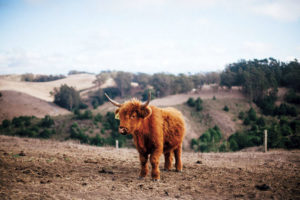
THE BAY AREA’S rangelands are an essential component of what makes the Bay Area one of the most biologically diverse metropolitan areas in the world. Annie Burke, deputy director of the Bay Area Open Space Council, a coalition of 65 organizations working to conserve open spaces, tells me that about 150,000 acres of rangeland are already protected under conservation easement and 585,000 more are protected through public agencies and land trusts. But private landowners have many more—1.3 million acres. Those lands are the new frontier of conservation.
“That’s one of the biggest shifts that’s happening in the Bay Area conservation community,” Burke says. “We’re moving from land acquisition to land stewardship. For 20 to 30 years there was a lot of work to buy land and protect it in perpetuity, but there are only so many more huge properties to buy.”
Burke says the best place to start with private land is to look for properties that connect protected areas, like the properties that line Salmon Creek. “I think there’s progress in the Bay Area to build a bridge between the working lands community and open space conservation,” Burke says. “There is pushback, but there’s more than one kind of conservation, and if we’re not paving over these open spaces, then I say we’re winning.”
“It was perfect.”
“What was perfect about it?” I ask.
“Well… it reminded me of New Zealand, where I came from,” says John. The hills and the forest. The ferns. The trees. And it’s close to the sea.”
“You can even hear the waves break, when the wind blows a certain way,” Lesley says.
Both Lesley and John knew they wanted to spend the rest of their lives on a working farm, and they looked all over: New Zealand, Australia, England, Scotland, Sweden.
“But here,” Lesley says, “is as beautiful, if not more so, than those places.”
I can see how this couple fell in love with Salmon Creek Ranch and the pastures around it—the landscapes are breathtaking. The livestock are part of the beauty, specks of black and white and brown amid the green.
“We don’t want to have to sell or develop the land,” Lesley says. “But as a farmer, you’ve got regulations, weather, predators—everything in the book—stacked against you. And the cost of land is so high!”
“Does Hipcamp help?”
“Of course,” she says. “It’s another income stream, which is really important, because we’re trying to make a living off this ranch. But there’s more to it than that. We feel very fortunate to have this property, and we like sharing it with people who appreciate the beauty, the quiet, the isolation of it.”
I tell Lesley that on Salmon Creek Ranch I feel something very different from isolation. In fact, I feel an intimacy with the land, one that grew out of the stories and experiences she and her husband shared with me.
“There’s history here,” she says. “A lot of people who own these ranches have been here for generations. If your cow gets out they’ll help you get it back. They know that back in ’38 the stream flooded; they know that’s the year the bridge washed out. They have all these stories. These families are connected to this land.”
That’s what I sense on the ranch: connection.
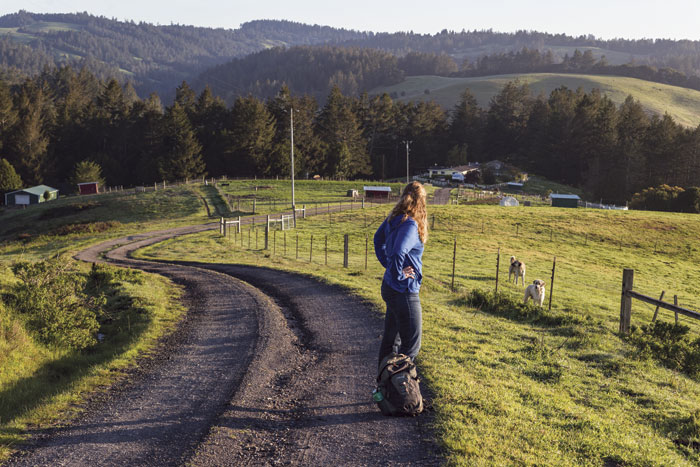
I DON’T WANT to leave.
I’m lying belly down in the grass, watching an orange-chested robin hop around about an arm’s length away. The breeze whisks the trees and rustles the buttercups. I listen to the creek gushing behind me. I lie still as cool waves of air pass over my back. While I lie in the meadow, the sun peeks over the hill. My first morning I rushed up that hill to catch the sun, but this time, it’s the sun that catches me.
Sabine Bergmann is a freelance writer, Spanish instructor, and aficionado of Berkeley’s Cheese Board pizza. Read her blogs, publications, and updates on her forthcoming book Jaded Altruism at sabinekbergmann.com.
Salmon Creek Ranch (salmoncreekranch. com) is open for ranch tours once a month. Hipcamp.com lists numerous private camping options.

